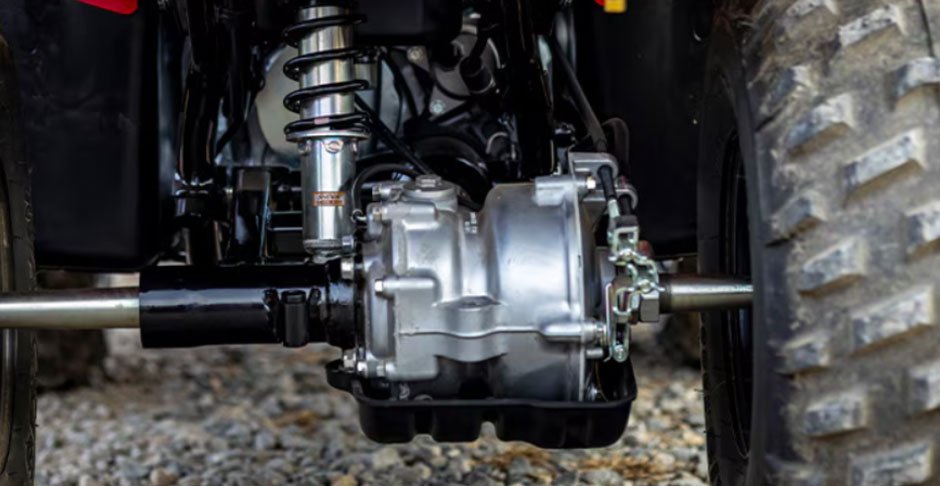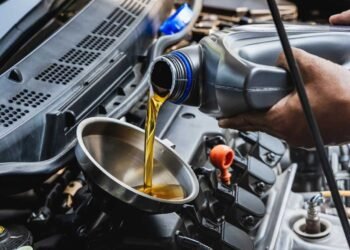While North American power sports brands were still digging their heels deep in snow, Japanese bike manufacturers, led by Honda, were conjuring what would become one of the best-selling off-road recreational vehicles of all time – the ATV. Honda introduced the first off-roading trike concept, the ATC90 in 1969, and advertised it in Bond movies (Diamonds are Forever) and popular TV shows of the day.
Even without promotional backing, the concept exploded in popularity, with rivals Yamaha and Kawasaki soon following suit. While Suzuki brought the first real quad bike to the market with their QuadRunner LT125, it was Honda that pioneered many segment firsts, including the world’s first 4×4 quad, the FourTrax 350 4×4.
Today, Honda offers a healthy line of both ATVs (the FourTrax Rancher, Rincon, Recon and Foreman) and side-by-sides (with the sports-oriented Talon and the Pioneer workhorse models) in varying displacement and power outputs.
The company also offers an extensive line of accessories, while a burgeoning aftermarket tends to parts troubling all power sports brands, including Honda ATV rear axle replacements, drive belts and brake upgrades. These coincidentally are parts that ATV and side-by-side owners will be repairing or replacing more often.
What Axles Do
With engine sizes ranging from 86ccs in the TRX90 to 999ccs in the Talon, axles bear different power outputs (5 to 105hp) and huge amounts of torque as they spin the wheels and get you going. They also bear the weight of your Honda ATV or SXS and ensure smooth handling by allowing you to turn and negotiate any obstacles along the way. While stock variants can last anywhere in the ballpark of 10,000 miles, bigger machines pumping out more torque (for more fun) will see axles front and rear, facing extreme stresses (heat cycling, torque, weight) and impact from rocks, branches and debris. Throw in common upgrades like lift kits and bigger tires for higher ground clearance, and these stresses become more pronounced.
Popping, bending, twisting and snapping axles aren’t all that uncommon. The stock front and rear axles on any Honda quad may be tough, but there are limits to how much they can endure. So before you blow any axle to pieces, ensure you have a spare around. This way you get to go on with the fun, complete work tasks, and get home unscathed. Replacement front and rear Honda axles are easy to find, relatively easy to swap out with basic tools, and won’t cost an arm and leg if you shop around.
Signs Your Honda is Up for a Replacement Axle
Axles are easy to replace because they come as pre-assembled units comprising shafts, joints and boots. Any one of these parts in stock guise can suffer from premature wear and damage. Shafts can bend or break, joints seize from friction and overheating, and thin thermoplastics can tear or rupture, spewing grease on wheels, tires and suspension parts. One or all of these issues can happen gradually or abruptly and leave you in the middle of nowhere. That’s where a replacement comes in handy.
Before this happens, look out for the obvious signs. These include popping and clicking sounds when turning, clunking noises when on the gas, unusual vibrations through the handlebars in ATVs or the steering wheel in side-by-sides and humming or whining sounds from the wheels. The most common reasons are ruptured CV boots and loss of grease, bad bearings, seized joints and bent shafts.
These issues can affect one axle, but it’s not uncommon to break two in a single go. How hard you’re on the throttle, where you ride or drive, and how many miles the stock units have under their belt all play a part. If you’re easier on the quad, then sure, all parts including the axles will last longer, provided they’re well-maintained. But if you’ve spent thousands on a thrill machine like the Talon, expect to replace axles, belts, and brake pads more often.
Aftermarket Options 
While OE parts promise a snug fit, they won’t provide much more durability or performance. This is why many Honda ATV and SXS owners turn to the aftermarket. If you’re having trouble with a front left or right, or Honda ATV rear axle, look for a better build, superior materials and axles engineered for your quad. Aftermarket brands usually sell these in heavy-duty and extreme-duty variants.
Heavy-duty replacements use treated and durable 5140-grade steel in the shafts, go with more metal for thicker diameters to handle higher stress rates, have machined joints for crisper power transfer, use industrial bearing for lower friction and higher compact resistance, and use thick rubber instead of plastics for the boots. Assembled as a unit, these are simple to install. They work well for general-purpose and recreational riding and can take a beating if you’re feeling more enthusiastic. ideal uses are for the front and rear of sports ATVS like the TRX quads, and most of the FourTrax lineup.
Honda SXS models pushing out more power and torque, and handling more weight (all Talon variants and heavy-duty Pioneer quads) are better off with extreme-duty axle replacements. These feature heat-treated 4340 chromoly steel to tame higher torque and heat levels, have extremely thick heat and puncture-resistant CV boots, feature CNC precision-machined joints and roll on induction-treated industrial ball bearings. Joints are additionally lubricated with high-pressure Moly grease for reduced friction and wear. Where they excel is in performance, quality and longevity. You can push bigger quads to their limits for longer and never fret that you’re having too much fun. Ideal uses are technical trails, rock crawling, high-speed runs and hauling thousand-pound loads at the work site.
To ensure you’re getting a quality product look for certified parts. This is the industry standard and international ISO/TS 16949 for automotive and vehicle parts and ISO 9001 for quality standards. Also, enquire about warranties. And lastly, consider pricing. Established brands also charge a premium, but there are infamous examples of top-tier brands with axles that have snapped in two just a few miles in. While quality and durability are often reflected in the end price, there are quite a few gems in budget third-party offerings. Shop for Honda axles in left and right and front and rear units, or go with pairs to save some cash, and have spares when you need them.












